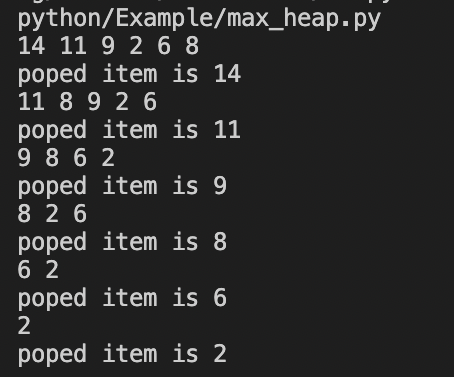1. 힙
- 내부 표현 : 동적배열, 완전 이진 트리
- 최대 힙과 최소 힙으로 나눌 수 있음
1) 최대 힙(max heap)
- 최대 트리이면서 완전 이진트리
- 최대트리 : 어떤 노드의 키가 자식의 키보다 작지 않은 트리
parent.key >= child.key - 완전 이진 트리 : 트리 높이가 h일 때 h-1레벨까지는 2^h-1 - 1의 노드를 가짐
- 인덱스를 0이 아닌 1부터 가짐
ex ) 14, 11, 9, 2, 6, 8 순으로 인덱스 1씩 증가 - 부모 인덱스 : 자식 인덱스 / 2
ex) 키 9를 가진 인덱스 / 2 = 1로 부모인덱스는 키 14를 가진 노드임 - 자식 인덱스 : 왼쪽 자식 노드의 경우 부모 인덱스 2, 오른쪽 자식 노드의 경우, 부모 인덱스 2 + 1
- index(parent) = index(child) // 2
- index(left_child) = index(parent) * 2
- index(right_child) = index(parent) * 2 + 1
- heapsize : 힙에 저장된 키의 개수 = 힙의 마지막 키의 인덱스
1-1) ADT
- Object : 키 속성을 지닌 요소 집합
- Operation
- h.is_empty() : Boolean, 힙이 비어있으면 True, 아니면 False
- h.is_full() : Boolean, 힙이 가득차있으면 True, 아니면 False
- h.push(element) : 힙에 요소 삽입
- h.pop() : element, 힙에서 최대 원소를 삭제하고 그 원소 반환
1-2) 구현
class Element:
def __init__(self, key):
self.key = key
class MaxHeap:
MAX_ELEMENT = 100
def __init__(self):
self.arr = [None for i in range(self.MAX_ELEMENT+1)]
self.heapsize = 0
def is_empty(self):
if self.heapsize == 0:
return True
return False
def is_full(self):
if self.heapsize >= self.MAX_ELEMENT:
return True
return False
def parent(self, idx):
return idx >> 1
def left(self, idx):
return idx << 1
def right(self, idx):
return (idx<<1) + 1- Element 클래스 : 우선적으로는 키값만 가지고 있음.
- parent 함수 : 인덱스를 매개변수로 받아 그 노드의 부모 인덱스 반환
- idx >> 1 == idx // 2
- left 함수 : 왼쪽 자식 반환
- idx << 1 == idx * 2
ex) 14, 2, 9 에 11 삽입
1) 완전 이진 트리 속성을 만족하기 위해 2의 왼쪽 서브트리로 11이 삽입됨 -> 최대 힙 특성 깨짐
2) 최대 힙 속성 만족을 위해 2와 11의 위치를 바꿈
- idx << 1 == idx * 2
def push(self, item):
if self.is_full():
raise IndexError("the heap is full")
self.heapsize += 1
cur_idx = self.heapsize
while cur_idx != 1 and item.key > self.arr[self.parent(cur_idx)].key:
self.arr[cur_idx] = self.arr[self.parent(cur_idx)]
cur_idx = self.parent(cur_idx)
self.arr[cur_idx] = itemself.heapsize += 1; cur_idx = self.heapsize;: 완전 이진 트리를 유지하기 위해 마지막 원소의 다음 인덱스에 삽입while cur_idx != 1 and item.key > self.arr[self.parent(cur_idx)].key:: cur_idx가 루트가 아니고 item의 키가 cur_idx 부모 키보다 큰 경우 실행
pop 연산 : 최대값을 삭제함 = 즉, 루트 삭제
1) pop() 을 통해 최대값인 루트 노드 삭제 -> 최대 힙 특성 깨짐
2) heap의 마지막 요소를 루트 노드로 대체함 = temp 값
3) temp값의 자식 노드 중 키가 더 큰 값을 선택하여 바꿔주면 됨
def pop(self):
if self.is_empty():
return None
rem_elem = self.arr[1]
temp = self.arr[self.heapsize]
self.heapsize -= 1
cur_idx = 1
child = self.left(cur_idx)
while child <= self.heapsize:
if child < self.heapsize and self.arr[self.left(cur_idx)].key < self.arr[self.right(cur_idx)].key:
child = self.right(cur_idx)
if temp.key >= self.arr[child].key:
break
self.arr[cur_idx] = self.arr[child]
cur_idx = child
child = self.left(cur_idx)
self.arr[cur_idx] = temp
return rem_elemtemp = self.arr[self.heapsize]; self.heapsize -= 1: 맨 마지막에 위치한 원소를 받아오면서 heapsize를 하나 줄임cur_idx = 1: 루트에서 시작child = self.left(cur_idx): 루트 왼쪽 자식while child <= self.heapsize:: child > self.heapsize면 arr[cur_idx]는 리프노드임.if child < self.heapsize and self.arr[self.left(cur_idx)].key < self.arr[self.right(cur_idx)].key : child = self.right(cur_idx): 오른쪽 자식이 있고, 오른쪽 자식의 키가 왼쪽 자식의 키보다 크면 child를 오른쪽 자식으로 이동if temp.key >= self.arr[child].key : break: 최대 힙 특성 만족 시 breakself.arr[cur_idx] = self.arr[child]; cur_idx = child: key가 큰 원소를 부모로 이동시킴.- 루트에 있는 키를 반환하고 빈 루트에 트리의 맨 마지막 원소를 임시로 올림. 자식 노드의 키값과 비교하며 자신의 위치를 찾아감
def print_heap(h):
for i in range(1, h.heapsize+1):
print("{}".format(h.arr[i].key), end=" ")
print()
if __name__ == "__main__":
h = MaxHeap()
h.push(Element(2))
h.push(Element(14))
h.push(Element(9))
h.push(Element(11))
h.push(Element(6))
h.push(Element(8))
print_heap(h)
while not h.is_empty():
rem = h.pop()
print(f"poped item is {rem.key}")
print_heap(h)
2. 우선순위 큐
- 키를 가진 원소 집합을 위한 자료 구조
- 힙으로 구현
2-1) ADT
- Object : 키를 가진 원소 집합
- Operation
- is_empty() : Boolean, 큐가 비어있음 True, 아니면 False
- push(item) : 큐에 Item 삽입
- pop() : element, 큐에서 키가 가장 작은 값 삭제하면서 반환
- min() : element, 큐에서 키가 가장 작은 값 반환
- decrease_key(item, new_key) : 큐에 있는 아이템의 키를 값이 줄어든 new_key 값으로 수정
- decrease_key() : 프림 알고리즘, 다익스트라 알고리즘에서 필요한 연산으로 현재 단계에서는 직접 구현하지 않음
- heapq 모듈 사용 : 우선순위 큐 구현을 위한 힙의 구현 제공(최소 힙만 제공), 인덱스도 0부터 시작함(루트 0부터 시작함)
2-2) 구현
from heapq import heappop, heappush
class Element:
def __init__(self, key, string):
self.key= key
self.data = string
class MinPriorityQueue:
def __init__(self):
self.heap = []
def is_empty(self):
if not self.heap:
return True
return False
def push(self, item):
heappush(self.heap, (item.key, item.data))
def pop(self):
return heappop(self.heap)
def min(self):
return self.heap[0]
if __name__ == "__main__":
pq = MinPriorityQueue()
pq.push(Element(2, "kim"))
pq.push(Element(14, "park"))
pq.push(Element(9, "choi"))
pq.push(Element(11, "lee"))
pq.push(Element(6, "yang"))
pq.push(Element(8, "jang"))
while not pq.is_empty():
elem = pq.pop()
print(f"key[{elem[0]}] : data[{elem[1]}]")heappush(self.heap, (item.key, item.data)): key, data를 튜플로 묶어서 전달